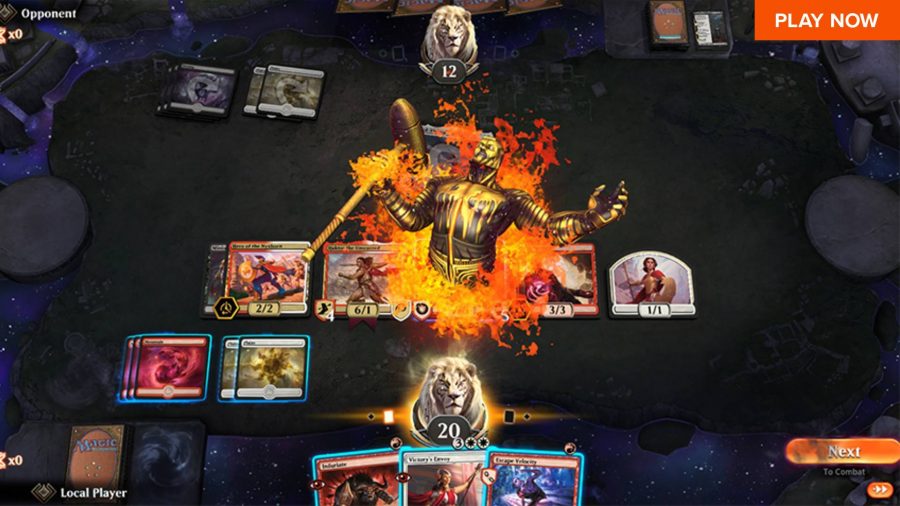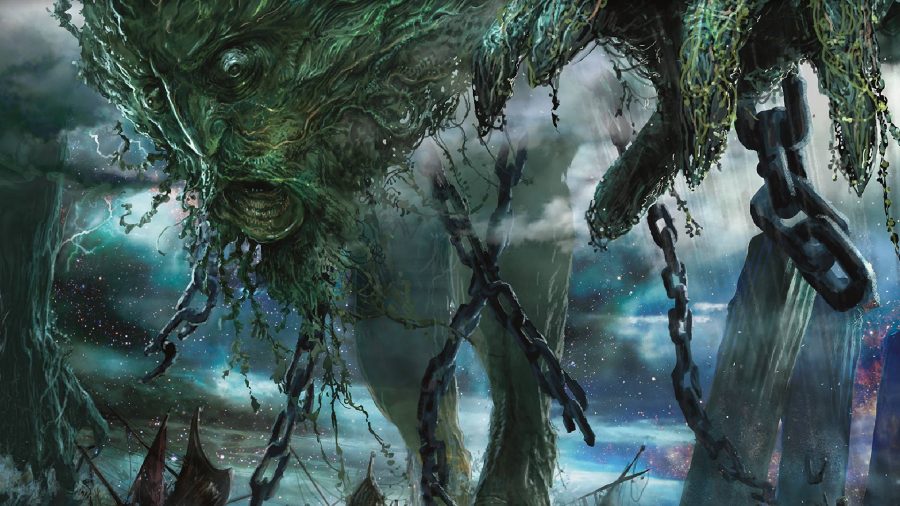How To Get A Draw In Magic The Gathering Arena
If you're starting out in Magic the Gathering, taking in all the rules of how to play MTG can be a fiddling overwhelming. Even if you've played card games earlier, Magic the Gathering is a jumbo CCG, with many rules, mechanics, and a rich lore to get alongside it.
The skillful news is, MTG: Loonshit is 1 of the all-time card games on PC and once you lot've brushed up on how to play MTG and got a few games under your belt, you'll be edifice decks and taking down opponents in no time.
This guide will have you through how to play Magic the Gathering, from the basic rules, game structure, and what kind of decks yous can expect to put together based on the cards available. If you need the comprehensive rules for MTG, this handy guide is great to refer to if you take a specific query. For now though, we'll stick to starting out in Magic the Gathering: Arena and everything you demand to know before your first match.
Magic the Gathering rules
Lands
In MTG, lands represent your mana pool. You'll need lands to play cards, equally each card has a land price. You can play only ane land per turn. Your lands stack up and can be used once per plow. Lands sit in your deck and brand upwards the 40 cards, so you desire to accept most 17-eighteen lands in your deck to make sure y'all draw plenty to play cards. In MTG: Loonshit, the deck architect recommends the lands and the amount you need based on your deck – pretty handy. Each colour has its own state variant, which you lot can find beneath.
- White – plains
- Blue – islands
- Black – swamps
- Light-green – forests
- Red – mountains
Land toll
Each card will have an associated land toll. You can observe this in the top right. It will either be a generic cost (which tin be played with whatsoever colour lands) or a specific land toll, so it could toll ane blue land, for case.
Tapping and untapping
Tapping and untapping cards is a big part of MTG – it's a fashion to use a card and in that location are a couple of means this works. Visually the card volition be turned horizontally if it is tapped, and volition exist vertical if it is untapped.
- All cards untap at the beginning of the role player's turn (except if a card dictates that it doesn't)
- Attacking on a histrion's turn taps a carte (except if information technology has vigilance), so it tin can't untap during the other thespian's plow (meaning your fauna that attacked won't be able to defend, as information technology is tapped)
- There are 'tap' and 'untap' symbols on some cards, which by tapping or untapping will activate an ability
- All creatures enter the battleground tapped, unless they have the keyword ability haste

Turn structure
Y'all'll start a normal match of MTG with 20 health, the game is over when one player reaches 0 health. There's a lot of toing and froing in MTG, passing from player to player, and although you have your own plough, spells and combat will still need to be resolved past the not-controlling histrion. There are five main phases per turn in MTG, the order will get a little something like this:
- Beginning phase – Untap all cards, draw a menu
- Main phase – A state can be played, controlling player can play spells
- Combat phase – Controlling player declares attacking (if any) creatures, non-decision-making player declares blocking (if whatever) creatures
- Post gainsay phase – This is essentially the aforementioned every bit your main phase, you lot can play spells with whatever remaining mana you may accept
- Stop phase – This is when the controlling player resolves any 'terminate of turn' spells before handing the control over to the other player
Library, graveyard, and exile
There are iii main bill of fare piles in Magic the Gathering, and it's important to know which pile cards belong in every bit the game progresses. Your library is your deck – this is the pile you'll draw a card from at the commencement of each round. The graveyard is where all spent and dead spells/creatures get. They are not exiled yet, and so y'all all the same might be able to replay them if you have a card that lets you fetch cards from your graveyard. The exile pile is non-real on the board itself, but it's the identify where cards go when they're really dead and can't be replayed back into the game.

Magic the Gathering carte du jour colours
At that place are five colours in Magic the Gathering and they all have their ain flavour, mechanics, and unique playing manner. You can have a one colour deck, or combine colours that compliment each other. There are too multicoloured, or gold, cards, where you lot'll need two colours to play them, or either one of a colour.
White
The colour white is all about damage prevention. Information technology's very defensive, and includes plenty of healing abilities and flying creatures. A white deck features a lot of smaller creatures and enchantments, also equally lath clearing cards. White decks focus on peppering the opponent, while maintaining a solid amount of health, with smaller creatures that are buffed using enchantment cards.
Blue
The colour blue is good for board command. The cards manipulate the board, casting many spells, drawing cards, and preventing the opponent'southward big moves. A blue deck allows you to draw from your library and offers more option when you're playing cards, it's a mix between small stubborn creatures that accept abilities that void your opponent's moves, and large creatures that have lath clearing abilities. Bluish also has a lot of cards that foreclose enemy spells and return spells to the owner'due south hand.
All easily: How to build a Magic: The Gathering deck
Blackness
Black centers around death and amorality. Information technology's principal mechanics discard cards and then return them back to your mitt or battleground. Black decks sacrifice cards and benefit from having a pool of creatures in the graveyard, by casting spells or gaining buffs based on the quantity in the graveyard. Black decks can besides forcefulness other players to discard cards, making it one of the more challenging decks to face.
Light-green
Dark-green has a lot of large creatures and beasts, and is able to prevent and destroy many opponent spells. Green deck creatures tend to accept more than toughness (health) and are all about withstanding the early game to cause chaos in the late game with high powered beasts.
Red
Ruby is fiery, and has a lot of damage dealing cards. It's an aggressive deck total of early game possibilities to accept down opponents. Building a red deck provides many early, lath immigration cards, simply information technology's not very defensive, and relies on taking out the opponent before yous run out of cards in your paw and frazzle your options. Red decks incorporate a lot of creatures with haste, meaning creatures enter the battlefield untapped, and are able to attack straight away.

What are planeswalkers in Magic the Gathering?
Planeswalkers in MTG are cards that don't human action as a normal card would. They notwithstanding count towards your deck, simply once they are drawn from the library and played, they sit outside of the battlefield. Planeswalkers have their own health, and this health can be spent on casting special abilities unique to that planeswalker. Once the planeswalkers health hits 0, then it's off to the graveyard pile. Opponents tin cull to assail your planeswalker instead of attacking you, and then you'll need to make sure you have a solid line of defense when playing a planeswalker.
Magic the Gathering mechanics
Card types
Magic the Gathering is fabricated up of permanents and non-permanents and all cards are referred to as spells (even creature cards). There are five permanents which are state, creature, artifact, enchantment, and planeswalker. In that location are 2 non-permanents – instant and sorcery. It's a handy affair to know, as some cards volition talk about 'permanents' and accept abilities that affect them in some way.
Keyword abilities
By at present you lot've probably seen that every carte du jour has text written on it. This text determines what that card can practise. Keyword abilities are static abilities, pregnant that they are not an action and are e'er active on that card, unless your opponent plays a carte du jour that says otherwise. Our guide to all the MTG keyword abilities tin can assist yous sympathise how they piece of work.
Keyword actions
Keyword deportment are something that happens when you play the card, or pay a mana price to activate. An case of this is Exile (exile a target creature) – keyword actions are almost e'er verbs. Check out our guide to all the MTG keyword actions for a deeper dive into their meaning.
Hopefully now y'all're set up to jump into Magic the Gathering: Arena. If yous're all defenseless up, you can observe out what we thought of MTG's latest expansions with our Ikoria Lair of Behemoths preview, and Theros Beyond Death preview. Magic the Gathering Arena is also free, check out other of the best free PC games on PC.
Source: https://www.pcgamesn.com/magic-the-gathering-arena/how-to-play-mtg
Posted by: blancharddeve1941.blogspot.com


0 Response to "How To Get A Draw In Magic The Gathering Arena"
Post a Comment